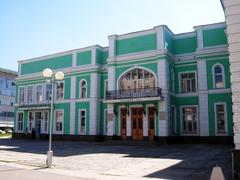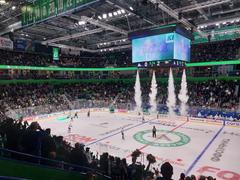Neftyanik Visiting Hours, Tickets, and Guide to Bashkortostan Historical Site
Date: 04/07/2025
Introduction to Neftyanik and Its Significance
Neftyanik, situated in the heart of Bashkortostan, Russia, is a testament to the region’s rich oil heritage and diverse cultural landscape. The name “Neftyanik” translates to “oil worker,” reflecting the area’s deep-rooted connection to the oil sector, which has shaped the economic and social fabric of Bashkortostan since the early 20th century. Visitors to Neftyanik and the wider region can experience a unique blend of Soviet-era industrial history, multiethnic traditions, and scenic natural beauty. Notable sites include oil industry landmarks, cultural centers, vibrant festivals, and stunning natural attractions such as the Bashkir State Nature Reserve and Shulgan-Tash Cave.
With Ufa as the main gateway—offering international flights and well-developed local transport—travelers have convenient access to Neftyanik. Accommodation options range from city hotels to health resorts renowned for their therapeutic mineral springs. The best visiting period is from late spring to early autumn, when the weather is mild and cultural events abound. This guide delivers comprehensive details on Neftyanik’s visiting hours, ticketing, tours, accessibility, cultural highlights, travel tips, and more, ensuring you have all the information needed for a seamless and enriching visit (History of Bashkortostan, Euromoney Bashkortostan Special Report, Travelertopia Ufa Guide).
Table of Contents
- Introduction
- Early Settlement and Prehistoric Roots
- The Bashkir People and the Formation of Bashkortostan
- Russian Expansion and Integration
- Industrialization and the Birth of Neftyanik
- Visiting Neftyanik: Practical Information
- Cultural Heritage and Attractions
- Natural Wonders and Nearby Attractions
- Climate and Best Time to Visit
- Frequently Asked Questions (FAQ)
- Plan Your Visit and Stay Connected
- Discover Neftyanik in Ufa: History, Culture, and Visitor Information
- Neftyanik Historical Sites and Practicalities
- Soviet-Era Heritage
- Multiethnic Culture
- Museums and Theatres
- Visiting Hours, Tickets, and Tours
- Natural Attractions (Southern Urals, Resorts, Outdoor Activities)
- Traditions and Crafts
- Festivals and Events
- Visitor Tips (Accessibility, Accommodation, Safety, Language, Tax)
- FAQs
- Visuals and Media Recommendations
- Internal and External Links
- Conclusion
- Neftyanik Monument: Visiting Hours, Tickets, and Travel Guide
- About Neftyanik
- Visiting Hours and Tickets
- Visitor Guidelines
- Getting There (Transportation, Local Transport)
- Accommodation and Dining
- Climate and Packing Tips
- Health, Safety, and Practicalities
- Cultural Etiquette and Customs
- Activities and Attractions
- FAQs
- Visuals and Media Recommendations
- Essential Tips
- Accessibility
- Sustainable Travel
- Conclusion
Discover Neftyanik and Bashkortostan: A Visitor’s Guide
Early Settlement and Prehistoric Roots
The region around Neftyanik has been settled since the Paleolithic era, as evidenced by archaeological finds including ancient tools and burial mounds. The Bronze Age introduced the Abashevo culture, renowned for advanced bronze work and permanent settlements, laying the foundation for Bashkortostan’s historical significance (History of Bashkortostan).
The Bashkir People and the Formation of Bashkortostan
Named after the Bashkir people—a Turkic ethnic group with a rich heritage—Bashkortostan’s culture is reflected in its language, customs, and arts. The Bashkirs historically practiced animal husbandry and trade, leveraging their strategic position at the crossroads of Europe and Asia. The region is noted for its multiethnic makeup, including Russians, Tatars, and other groups (History of Bashkortostan).
Russian Expansion and Integration
Bashkortostan’s integration into the Russian state accelerated after the fall of the Kazan Khanate in 1552. Ufa’s founding in 1574 as a military and administrative center further developed the region. Despite periodic uprisings, Bashkortostan grew into a multicultural hub (Tourist Places Guide).
Industrialization and the Birth of Neftyanik
The discovery of oil in the late 19th and early 20th centuries transformed Bashkortostan, with Neftyanik emerging as a key settlement for oil extraction and processing. Soviet investment in refineries and infrastructure cemented Neftyanik’s role as a center of industrial and residential life.
Visiting Neftyanik: Practical Information
Visiting Hours:
Neftyanik itself is a functioning district rather than a single tourist site, but industrial museums and cultural centers in Ufa and surrounding towns are typically open from 10:00 AM to 6:00 PM daily.
Tickets:
Admission to museums and cultural sites generally ranges from 100–300 RUB. Many natural attractions are free.
Guided Tours:
Tour operators in Ufa offer guided visits to oil industry facilities, cultural sites, and natural parks. Advance booking is recommended.
Accessibility:
Neftyanik and nearby attractions are accessible from Ufa by road, with public transportation available. Check local schedules for current routes and times.
Cultural Heritage and Attractions
Bashkortostan is known for its vibrant cultural scene, with festivals featuring Bashkir music, dance, and cuisine. Villages like Aksakovo are famous for crafts such as weaving and pottery (Tourist Places Guide). The Friendship Monument in Ufa stands as a symbol of unity among different peoples (Friendship Monument).
Natural Wonders and Nearby Attractions
Key natural sites accessible from Neftyanik include the Bashkir State Nature Reserve and Bashkiria National Park (Bashkir State Nature Reserve), and the Shulgan-Tash Cave with ancient rock art (Shulgan-Tash Cave). These make Neftyanik a convenient base for exploring Bashkortostan’s diverse landscapes.
Climate and Best Time to Visit
Bashkortostan’s climate is humid continental, with warm summers and cold winters. The average annual temperature is about 4.93°C (40.87°F) (Weather and Climate). May to September is ideal for travel, when weather conditions are pleasant and cultural events are frequent.
Frequently Asked Questions (FAQ)
-
What are Neftyanik’s visiting hours?
Neftyanik’s public sites are generally open from 8:00 AM to 8:00 PM. Museums and cultural centers operate from 10:00 AM to 6:00 PM. -
How do I buy tickets for attractions?
Tickets are available at museum entrances or through local tour operators. Many natural sites are free. -
Are guided tours offered?
Yes, guided tours focusing on oil industry history, Bashkir culture, and natural parks are available. -
How do I get to Neftyanik?
The district is easily reached by public transport or taxi from Ufa.
Plan Your Visit and Stay Connected
To enrich your trip, download the Audiala app for interactive maps, audio guides, and the latest information on Neftyanik and Bashkortostan. For updates and travel tips, subscribe to our newsletter and follow us on social media.
Discover Neftyanik in Ufa: History, Culture, and Visitor Information
Historical Context
Neftyanik’s identity is closely tied to Bashkortostan’s oil industry, which began in earnest in 1932. Ufa quickly became a hub for oil refining, with major facilities like the Ufa Oil Refinery driving economic growth (Euromoney).
Economic and Industrial Significance
The oil sector is central to Ufa’s economy. The refining complex processes over 21 million tonnes of oil annually, supporting both local employment and the wider Russian energy market. Educational institutions such as Ufa State Petroleum Technological University play a key role in training industry professionals (Euromoney).
Urban Development and Infrastructure
Neftyanik’s urban character reflects its industrial roots, with well-planned neighborhoods, abundant green spaces, and community amenities. The district’s development is closely linked to the growth of the oil industry and the wellbeing of its residents.
Cultural and Social Impact
The Neftyanik legacy is celebrated in festivals, public art, and community events. Notably, traditional Russian banyas—like the Neftyanik banya—offer visitors a classic sauna experience (Xplrverse).
Visitor Guide to Neftyanik in Ufa
Neftyanik Attractions and Visiting Hours
- Neftyanik Banya: Open daily from 8:00 AM to 10:00 PM, with entry fees from 300–500 RUB. No advance tickets required.
- Sports Facilities: Open during scheduled events; check local listings for details.
Guided Tours and Accessibility
City tours of Ufa often include the Neftyanik district, highlighting both industrial heritage and cultural sites. The area is generally wheelchair accessible, with public transport accommodating mobility needs.
Getting There and Around
Neftyanik is served by Ufa’s public transport (buses, trams), with taxis and ride-hailing services widely available. Its central location allows for easy access to other city attractions.
Accommodation
Visitors can choose from a range of accommodations in central Ufa, with convenient access to the Neftyanik district (Pineqone).
Things to Do
- Experience a traditional banya.
- Enjoy green parks and recreational areas.
- Attend local sports events.
- Sample Bashkir and Russian cuisine (TravelSetu).
Best Time to Visit
Late spring and early autumn offer mild weather—ideal for outdoor activities (Pineqone).
Language and Communication
Russian is predominant; Bashkir and Tatar are also spoken. English is limited, so learning basic Russian phrases or using a translation app is recommended (Wikipedia).
Currency and Costs
The Russian ruble (RUB) is the official currency. Ufa is affordable compared to major Russian cities, with reasonable costs for food, accommodation, and transport (Pineqone).
Architectural and Urban Highlights
The Neftyanik district features Soviet-era residential buildings amidst green spaces, reflecting Ufa’s reputation as one of Russia’s greenest cities (Restgeo). Notable nearby landmarks include the National Museum, the Bashkir State Opera and Ballet Theatre, and the Monument of Friendship (TravelSetu).
Practical Visitor Information
Accessibility and Transportation
Neftyanik is accessible by road and rail, with reliable public transport and taxi services. Major roads and the M5 “Ural” highway connect the district with Ufa and other cities (RussiaTrek).
Accommodation and Amenities
Options range from guesthouses to hotels, with more choices in Ufa. Local restaurants offer Russian, Bashkir, and Tatar dishes.
Safety and Etiquette
The region is safe; standard precautions apply. Dress modestly at religious sites and respect local customs.
Language and Communication
Russian is the main language; Wi-Fi is widely available in urban areas, but mobile SIM cards may be harder to obtain for foreigners (penguintravel.com).
Tourist Tax and Registration
A tourist tax of 1% of lodging costs is payable onsite. Foreign visitors must register their stay, typically handled by hotels (penguintravel.com).
Festivals and Events
Notable celebrations include Sabantuy (summer festival), Oilman’s Day (parades and concerts), and religious holidays like Eid al-Fitr and Orthodox Easter.
Neftyanik Monument: Visiting Hours, Tickets, and Travel Guide
About Neftyanik
This monument near Krasnokholmsky honors the region’s oil workers and showcases the industrial development that shaped modern Bashkortostan.
Visiting Hours and Tickets
- Open: Daily, 9:00 AM to 6:00 PM
- Tickets: Monument access is free; guided tours or exhibitions may charge 200–500 RUB.
- Guided Tours: Available by request; advance booking recommended.
Visitor Guidelines
Photography is allowed (drones require permission). Respect the monument and avoid climbing.
Getting to Neftyanik
Neftyanik is accessible from Ufa (the main gateway) by train, bus, or car. The M5 “Ural” highway facilitates regional travel (Euromoney, RussiaTrek).
Local Transport
Urban transport is reliable; for rural visits, private transfers or car rentals are advised.
Accommodation and Dining
Stay in Ufa, Sterlitamak, or Salavat, where hotels and sanatoria are plentiful (Euromoney). Bashkir cuisine highlights include bishbarmak, chak-chak, kazy, and local honey.
Climate and Best Time to Visit
The climate is continental: cold winters (-18°C) and warm summers (+18°C) (RussiaTrek). Summer is best for outdoor activities; winter is ideal for ski resorts.
Health, Safety, and Practicalities
Healthcare is good, with many sanatoria. Pharmacies are widespread. Carry basic medications and bottled water for rural trips. The Russian Ruble is the currency; credit cards are accepted in urban areas (Russian-e-Visa).
Cultural Etiquette
Dress modestly, especially in religious sites. Hospitality is valued; small gifts are customary when visiting homes (Russian-e-Visa).
Activities and Attractions Near Neftyanik
Highlights include hiking, horseback riding, rafting, skiing (at resorts like Abzakovo), and visits to the Shulgan-Tash Reserve’s Kapova Cave (Euromoney, RussiaTrek). Ufa offers museums, theaters, and folk events (Tropki).
Essential Visitor Tips
- Connectivity: Good mobile coverage in cities; limited in rural areas.
- Internet: Wi-Fi in hotels and cafes.
- Electricity: 220V, European plugs (C, F).
- Documentation: Carry your passport and migration card.
- Visas: Most visitors need a visa; check requirements (WeWillNomad).
- Emergency: Dial 112 for services.
Sustainability
Travel responsibly—respect trails and wildlife, support local craftspeople, and minimize waste.
Visuals and Media Recommendations
View images, maps, and virtual tours on travel sites. Use descriptive alt tags for accessibility and search optimization.
References and Useful Links
- History of Bashkortostan
- Euromoney Bashkortostan Special Report
- Travelertopia Ufa Guide
- Tourist Places Guide to Bashkortostan
- Friendship Monument
- Bashkir State Nature Reserve
- Shulgan-Tash Cave
- Weather and Climate of Bashkortostan
- Xplrverse Neftyanik Guide
- Things to Do in Ufa – TravelSetu
- Popular Attractions in Ufa – Restgeo
- Council.gov.ru Bashkortostan Overview
- RussiaTrek Bashkortostan Guide
- PenguinTravel Cultural Tours
- Tropki Bashkortostan Tourism
- HelloTravel Bashkortostan Events
- Trip.com Neftyanik Page
- WeWillNomad Russian Visa Tips


